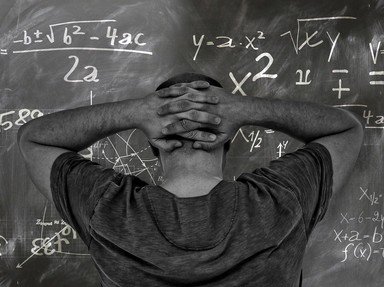Quiz Answer Key and Fun Facts
1. Emmy Noether was one of just two women at this German university when she studied there from 1900 to 1903. She had to receive permission from each professor whose course she took. Which university was this?
2. Fill in the blank in the name of Emmy Noether's dissertation, "On Complete Systems of Invariants for Ternary Bi_____ Forms". The missing part of the word is a type of expression, an example of which is depicted.
3. The postcard pictured was sent by Emmy Noether to a colleague, one of her most important influences, who worked in an area of mathematics called analysis. He shares his surname with a famous chess player. What is his name?
4. In 1915, Emmy Noether was invited to the University of Göttingen by philosophy academics, though she was delayed in taking up the position by department members who opposed women at universities. One academic who initially invited Emmy has a type of topological surface that looks like a bottle named after him. What is his name?
5. While teaching in Göttingen, Emmy Noether often had to advertise her courses under a male academic's name, and her role was formally as an assistant. This mathematician was a polymath, perhaps most famously lending his name to a type of vector space and a collection of 23 important mathematical problems that were unsolved at the turn of the 20th century. What is his name?
6. After a revolution in Germany in 1918 that abolished the monarchy and led to Kaiser Wilhelm II's abdication, women were allowed to more fully participate in universities. Emmy Noether, following a successful oral exam, became a professor - though she was still unpaid. What was the name of the revolution?
7. Within abstract algebra, Emmy Noether studied a mathematical structure containing values that can be added and multiplied with each other, and have additive inverses. An example of this structure is the whole numbers (integers), and another is polynomials. It shares its name with the depicted object. What is it?
8. Related to the German revolution of 1918, Emmy Noether supported the belligerents of the Russian Revolution, and spoke positively of the advances in mathematics and science by which Marxist group that was founded by Vladimir Lenin and split with the Mensheviks?
9. In 1933, Emmy was dismissed from her university position by the Nazis due to her Jewish heritage. For a few months she continued teaching informally, and then she moved to the Bryn Mawr College. The institution is part of which collection of American colleges?
10. Emmy Noether died apparently due to tumors or cysts in her reproductive system, four days after surgery to remove a cyst from what circled part of her body?
Source: Author
AdamM7
This quiz was reviewed by FunTrivia editor
LeoDaVinci before going online.
Any errors found in FunTrivia content are routinely corrected through our feedback system.
